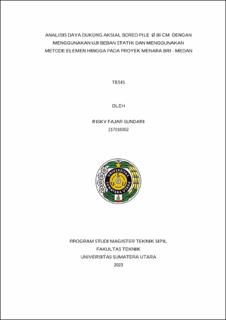| dc.contributor.advisor | Roesyanto | |
| dc.contributor.advisor | Hasibuan, Gina Cynthia Raphita | |
| dc.contributor.author | Sundari, Risky Fajar | |
| dc.date.accessioned | 2024-08-28T08:51:20Z | |
| dc.date.available | 2024-08-28T08:51:20Z | |
| dc.date.issued | 2023 | |
| dc.identifier.uri | https://repositori.usu.ac.id/handle/123456789/96302 | |
| dc.description.abstract | The high population in various large cities such as Medan City makes the
development of buildings in this city increasingly rapid. This affects the need for
piles on a building's foundation because the development of a building that has a
vertical concept requires a strong foundation to accept the load from the upper
structure. The foundations used in the city of Medan generally use bored pile
foundations, because these foundations, which are classified as deep foundations,
have a small vibration impact during construction and are suitable for use in
densely populated areas. This really determines the bored pile foundation design
that suits the project needs.
One of the strategies that will be used for the problem in this research is by
collecting data from the project such as soil data which will then be analyzed using
the Reese and O'Neill method to obtain the bearing capacity value from the SPT
test results and we will calculate the amount of settlement that occurs in the bored
foundation. pile at point BH-2 of the BRI-Medan Tower project using analytical
calculations and the finite element method using PLAXIS 2D and 3D software using
Mohr-Coulomb and Hardening Soil types of soil.
After the analysis, the ultimate bored pile carrying capacity value based on
SPT data using the O'Neill and Reese equation is 565 tons, then analysis using the
Davisson method is 410 tons, using the Mazurkiewiech method is 350 tons and the
Chin method gives a carrying capacity of 344 tons. tons. And for the settlement
value that occurs in the bored pile foundation at point BH-2, analytically the
settlement is 3.80 mm, which we then compare using the FEM PLAXIS 2D Mohr-
Coulomb program, the decline is 4.51 mm and the Hardening Soil decline is 3 .85
mm, as well as analysis based on FEM PLAXIS 3D Mohr-Coulomb decrease of
3.87 mm, and Hardening Soil decrease of 3.41 mm.
Based on the results of the analysis, it can be concluded that the O'Neil and
Reese equation provides a greater value than the interpretation of the loading test
so that it will provide a large safety value if used during design and settlement
analysis. The results in the field is the analysis with PLAXIS 3D with the Hardening
Soil. | en_US |
| dc.language.iso | id | en_US |
| dc.publisher | Universitas Sumatera Utara | en_US |
| dc.subject | Bearing Capacity | en_US |
| dc.subject | Settlement | en_US |
| dc.subject | Bored pile | en_US |
| dc.subject | FEM | en_US |
| dc.subject | SDGs | en_US |
| dc.title | Analisis Daya Dukung Aksial Bored Pile Ø 80 Cm dengan Menggunakan Uji Beban Statik dan Menggunakan Metode Elemen Hingga pada Proyek Menara BRI – Medan | en_US |
| dc.title.alternative | Analysis of Axial Bearing Capacity of Bored Pile Ø 80 Cm Using Test Static Loads and Using the Finite Element Method in Projects BRI Tower – Medan | en_US |
| dc.type | Thesis | en_US |
| dc.identifier.nim | NIM217016002 | |
| dc.identifier.nidn | NIDN0029065102 | |
| dc.identifier.nidn | NIDN0010108906 | |
| dc.identifier.kodeprodi | KODEPRODI22101#Teknik Sipil | |
| dc.description.pages | 122 Pages | en_US |
| dc.description.type | Tesis Magister | en_US |


